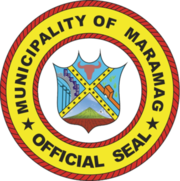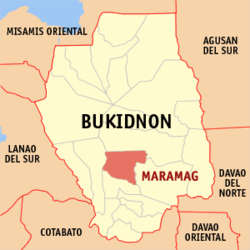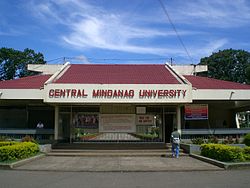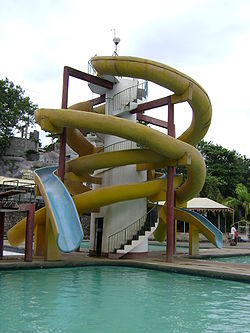- Maramag, Bukidnon
-
Municipality of Maramag
SealNickname(s): The Place For Secured Investment Map of Bukidnon showing the location of Maramag, Bukidnon Coordinates: 7°50′N 125°00′E / 7.833°N 125°E Country Philippines Region Region X Province Bukidnon Districts 3rd District Barangays 20 Incorporated (town) 1951 Government - Mayor Alicia P. Resus - Vice Mayor Area - Total 521.99 km2 (201.54 sq mi) Population (2000) - Total 75,233 - Density 144/km2 (374/sq mi) Time zone PST (UTC+8) ZIP code 8714 Area code(s) 88 Maramag is a 1st class municipality in the province of Bukidnon, Philippines. According to the 2009 census, it has a population of 86,647 people in 19,267 households based on 2000 census.Maramag local government unit launched its official website www.maramag.gov.ph on July 9, 2008.
Contents
History
Political and Cultural History
Maramag from “Ag Ramag” a contracted Manobo term for “Ag Ramag Ki Dini”, which as freely translated, means “Let us eat our breakfast here.” The story as officially published by the late Prescioso Velez Abellanosa Sr. (a former municipal mayor) goes that the Manobos were constantly in conflict with the Maranaos for supremacy over the locality. Each time they set out for the battle they would stop on the bank of Pulangi River where flat stones that serve as their tables abound the area. Atop of these, they would draw their plans and eat their breakfast. This habit becomes their practice that even in times of peace and as a sign of good faith, these “Lumads”, the natives or early settlers invite others who happen to pass by to partake meals with them. Maramag then was a picnic ground were one can rest and take his meal as a short respite either from travel, trekking, hunting and trapping or from battle.
Through the years, even Christians (referred to as "Dumagats", literally 'seaborne/coming from beyond the sea') started to come and settle near the place. They too would stop and eat their meals on these big flat stones during hunting trips or as they travel on foot from one valley to another. As more and more Christian settlers occupied the surrounding places, Ag Ramag became more commonly called as Maramag – a homonym or a contraction of the original Manobo term “Ag Ramag”.
The political history of the municipality traces back in 1916 when the late Deputy Governor Cenon R. Paulican positively declared that people from different parts of the country began settling in the area. Years later, the people informally elected a leader among them as the incipient local government started to take form. They called their leaders “Captain”. These leaders normally remained in office for as long as their political abilities and faithfulness to duty would allow; Monarchial in so many ways although an election process is in place. This system prevailed up to the Second World War.
In 1945, the first appointed Mayor was put in place to head the municipal government followed by two others. The first election for the position of the Municipal Mayor was held in 1951. The election for the members of the Barrio Council was held in 1955. From then on, ten other Municipal Mayors were either appointed or elected in the past 56 years up to the present.
Maramag was formally created as a municipality through Executive Order No. 272 issued by then President Carlos P. Garcia on July 1, 1956. The Poblacion of Maramag was formerly located in Barangay Base Camp, three (3) kilometers away from the present Poblacion. After the World War II and upon the completion of the Sayre Highway, people started to move along the highway in a linear then nodal fashion and later concentrically forming the Poblacion today, composing Barangay North and South Poblacions.
The municipal boundaries between Maramag, Pangantucan and Kibawe were established in 1935 by the then deputy Governor Cenon Paulican. Then, Maramag, with the organization of the former barangays Don Carlos and Quezon into regular municipalities, was reduced to its present area of about 58,198.98 hectares. As reported too, in the late sixties, a Memorandum of Agreement between Maramag and Valencia, Bukidnon was forged as to their common boundaries. Purportedly, the Lumbo Creek, as it flows to the Pulangi River defines the demarcation between the two municipalities.
The current seat of the government of Maramag consists of two barangays: the North and South Poblacion. When the Central Mindanao University (CMU) is transferred to Musuan, Dologon, Maramag, Bukidnon from Managok, Malaybalay, Bukidnon, the municipality became the host of the premier agricultural school in Mindanao.
The municipality likewise served as the nodal point of the major national roads of the province to the different places of Mindanao namely: the Bukidnon–Wao (Lanao del Sur) road the Bukidnon – North Cotobato Road and the Bukidnon – Cagayan de Oro Road.
Maramag boasts its agricultural importance to the development of the province. It has the Crystal Sugar Corporation with a rated capacity of 6,000 tons per day. As of 1999, the total area planted to sugarcane was 20,500 hectares, which ranked as the number one crop. Corn ranks second with 10,800 hectares planted and rice accounts for the third major crop in the municipality with the irrigated areas reaching 4,900 hectares.
The National Power Corporation (NAPOCOR) Pulangi IV Hydroelectric Plant with a rated capacity of 255 megawatts is found in Maramag. The Power Plant contributed the Mindanao Grid.
In terms of environment, the municipality plays a vital role in the protection of the Bukidnon Watershed. Thirty percent of the land, approximately 17,340 hectares, of Maramag has been designated as forest land. These include the protected forest (10.45%), production forest (85.85%) and buffer zones (3.7%). The forest area categorized under the NIPAS is the 1,939.62 hectares within the confines of Mt. Kalatungan Range, the third highest mountain of the country.
Physical Features
Geographic Location
Maramag, a landlocked municipality of Bukidnon, is approximately 158 kilometers southeast of Cagayan de Oro City, around 53 Kilometers south of Malaybalay City and 154 Kilometers from Davao City. The municipality is strategically located as it can be reached through any of the cities mentioned, aside from Kibawe, which should connect it to the Cotabato provinces via Carmen Bridge over the Rio Grande de Mindanao. It is bounded on the north and northeastern by the municipality of Valencia; on the east by the municipality of Quezon; on the south by the municipality of Don Carlos; and on the west by the municipality of Pangantucan, all within the Province of Bukidnon. It is located within the geographic coordinates of 7°41’, to 7°58’ North latitude and 124°47’ to 125°14’ East longitude.
Land Area
Maramag covers a total land area of 52,198.98 hectares and politically divided into 20 barangays. The largest barangay is Kuya.
Topography
Mountain Ranges
Maramag is bounded in the North-East by mountain ranges of Mt. Kilakron and Mt. Kalatungan. Among its important landmarks are the Adtuyon Plateau and the Musuan Peak, at the base of which lies the well known Central Mindanao University (CMU), a state university at Musuan, Dologon.
Slopes
The municipality is well distributed in terms of slope gradients. The eastern and central sections of Maramag except in some patches are characteristically flat but undulated towards the northern and western boundaries of the area.
Areas having slopes of 0–18 percent occupies almost half (48.84 %) of the entire municipality with the 0-3% slope category accounting for 26.47 percent. Another slope category with considerable area is the 8-18% occupying around 9,014.76 hectares and comprising 17.27 percent of the total land area. The largest area in Maramag in terms of the slope grouping is the 18-30%, which comprised 27.39 percent of the land area or an equivalent area of 14,297.30 hectares. The very steep hills and mountains (50% and above in slope) in Maramag occupy only 6,566.63 or 12.58% of the total land area. These areas are located mostly in the western and northern boundaries of Maramag.
Water Bodies
Bodies of water abound the area, the Baguic-ican river in the east, flowing downstream as tributary of Muleta River that drains in the South to Don Carlos; and the Maramag River whose tributaries upstream originates from the central portion of the municipality, which flows further towards the Pulangi River. Another tributary to Pulangi River that flows within the area are the Kibalagon Creek and the Kulaman River, both found in the North East.
Only Pulangi Watershed is identified to have an influence on the availability of water resources in Maramag.
The People
Ethnic Origin of the People
The population in the municipality is a mixture of different tribal origins. We can observe people speaking in different dialects/languages which are an implication of being foreign or in migrant to the locality.
Based from historical accounts, the original inhabitants of Maramag came from the blood of Manobos and Maranaos. Through the years, Christians or Dumagats started to come and settle in the area. Among them, Cebuano tongue predominated the place, while other majority groups find their living in all the corners of Maramag, although Lumads can still be found.
Languages/ Dialects
As shown in the Calendar Year 2000 Census of Population, the inhabitants of Maramag is composed of 77 carried ethnic groups. Cebuano is the dominant group among these carried ethnic groups. Other ethnic groups of higher headcount include Boholano, Hiligaynon/ Ilongo, Bukidnon, Ilocano and Tagalog.
Business Profile
Agriculture
- Inland Fishery and Hatchery
Locations:Magsaysay, Kuya and 5 Barangays along Sayre highway
- Magsaysay Hatchery, a dynamic aqua-culture hatchery center serving the needs of the freshwater fisheries sector. Locations of Inland Fisheries include NAPOCOR Man-made Lake, NAPOCOR Channel and NAPOCOR Surge Pool area and other private fish ponds.
- Techno Demo Farm
Location/s:Magsaysay, Kuya
One of the highlights of the Municipal Agri-Tourism Rural Enterprise (MARE) where Agricultural Technology is enhanced and developed.
- DOLE Skyland
Location: Dagumbaan
Banana Plantation with a total area of 800 hectares. The plantation contributes to the supply of bananas exportation of the known DOLE Company.
Industry
- Waig Crystal Spring Resort
Location: Publacion Maramag Bukidnon Website: www.workinstruments.ph.tc
- Seri Culture
Location: Kiharong
A Mulberry Production-one of the contributors to the country’s silk fiber supply for exportation.
- Pulangi IV Hydro Electric Plant
Location: Kiuntod, Camp 1
With rated capacity of 255 megawatts, the power plant supplies power in various provinces of Mindanao generating at a much lower cost.
- CRYSTAL SUGAR COMPANY, INC.
Location: North Poblacion
With an investment of P10M and an average daily production of 1,000MT, CSCI renders services to 151 regular employees and 70 seasonal services workers.
- MERIBA Purified Drinking Water
Water from the Rock
Mineral and Purified Drinking Water just within the EDLIMAR Spring Resort's periphery.
Barangays
The municipality of Maramag is composed of twenty (20) barangays. It is subdivided into 204 Sitios/ Puroks. Two (2) barangays are categorized as Urban Centers: the North and South Poblacions; and eighteen (18) rural barangays.
- Anahawon
- Base Camp
- Bayabason (Spring)
- Camp I
- Colambugon
- Dagumba-an
- Danggawan
- Dologon
- Kisanday
- Kuya
- La Roxas
- Panadtalan
- Panalsalan
- North Poblacion
- South Poblacion
- San Miguel
- San Roque
- Tubigon
- Bagongsilang
- Kiharong
External links
Municipalities Baungon • Cabanglasan • Damulog • Dangcagan • Don Carlos • Impasug-ong • Kadingilan • Kalilangan • Kibawe • Kitaotao • Lantapan • Libona • Malitbog • Manolo Fortich • Maramag • Pangantucan • Quezon • San Fernando • Sumilao • TalakagComponent cities Malaybalay • ValenciaCategories:- Municipalities of Bukidnon
Wikimedia Foundation. 2010.




